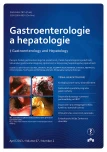Multifocal hepatocellular carcinoma imitating hepatal cirrhosis
Authors:
M. Horvatová 1; R. Keil 1; M. Roznětinská 1; J. Chudý 1; M. Grega 2; A. Mazáková 3
Authors place of work:
Interní klinika – oddělení gastroenterologie 2. LF UK a FN v Motole
1; Ústav patologie a molekulární medicíny 2. LF UK a FN v Motole
2; Klinika zobrazovacích metod 2. LF UK a FN v Motole
3
Published in the journal:
Gastroent Hepatol 2013; 67(2): 111-114
Category:
Hepatologie: kazuistika
Summary
In this article, we describe a case of a 40-year-old man admitted to hospital with icterus. During the examination process, liver cirrhosis was suspected. Metabolic liver diseases and autoimmune hepatitis were excluded by examination. Because of alcohol abuse and negative results of the examinations, the etiology of liver cirrhosis was concluded as toxonutritive. After consultation with the Institute of Clinical and Experimental Medicine, liver transplantation was contraindicated due to assumed toxonutritive etiology of cirrhosis. During hospitalization, acute liver failure developed. The patient was urgently transferred to the intensive care unit, where a few days later he died of liver failure with multi-organ damage. The autopsy revealed multifocal hepatocellular carcinoma.
Key words:
hepatal cirrhosis – terminal liver failure – multifocal hepatocellular carcinoma
Zdroje
1. Bosch FX, Ribes J, Diaz M et al. Primary liver cancer: worldwide incidence and trends. Gastroenterology 2004; 127 (5 Suppl 1): S5–S16.
2. Yuen MF, Hou JL, Chutaputti A. Hepatocellular carcinoma in the Asia pacific region. J Gastroenterol Hepatol 2009; 24(3): 346–353.
3. Umemura T, Ichijo T, Yoshizawa K et al. Epidemiology of hepatocellular carcinoma in Japan. J Gastroenterol 2009; 44 (Suppl 19): 102–107.
4. Yang JD, Harmsen WS, Slettedahl SW et al. Factors that affect risk for hepatocellular carcinoma and effects of Hepatology Research 2012; 42: 1–14 HCC in NASH 9 © 2011.
5. Kensler TW, Qian GS, Chen JG et al. Translational strategies for cancer prevention in liver. Nat Rev Cancer 2003; 3(5): 321–329.
6. Mendizabal M, Reddy KR. Current management of hepatocellular carcinoma. Med Clin North Am 2009; 93(4): 885–900.
7. Bosch FX, Ribes J, Díaz M et al. Primary liver cancer: worldwide incidence and trends. Gastroenterology 2004; 127 (5 Suppl 1): S5–16.
8. Cao H, Phan H, Yang LX. Improved chemotherapy for hepaocellular carcinoma. Anticancer Res 2012; 32(4): 1379–1386.
9. Brůha R, Šperl J, Urbánek P et al. Doporučené postupy v diagnostice a léčbě hepatoocelulárního karcinomu. Gastroenterol Hepatol 2012; 66(2): 83–92.
10. Hamilton SR, Aaltonen LA (Eds.). World Health Organization Classificatin of Tumours. Pathology and Genetics of Tumours of the Digestive Systém. IARC Press: Lyon 2000.
Štítky
Dětská gastroenterologie Gastroenterologie a hepatologie Chirurgie všeobecná Interní lékařství Nutriční terapeut ObezitologieČlánek vyšel v časopise
Gastroenterologie a hepatologie

2013 Číslo 2
- Není statin jako statin aneb praktický přehled rozdílů jednotlivých molekul
- Metamizol jako analgetikum první volby: kdy, pro koho, jak a proč?
- Horní limit denní dávky vitaminu D: Jaké množství je ještě bezpečné?
- Když ženám stoupá tlak... aneb jaká jsou specifika terapie hypertenze u žen (2. díl)
Nejčtenější v tomto čísle
- Danišův jícnový stent v terapii varikózního krvácení
- Mutaflor – Escherichia coli kmen Nissle 1917, sérotyp O6:K5:H1
- Cholangiopankreatoskopie pomocí SpyGlassTM direct visualization system: seznámení s metodou a první vlastní zkušenosti
- Multifokální hepatocelulární karcinom imitující jaterní cirhózu
